Dyker Heights, Brooklyn
| Dyker Heights | |
|---|---|
| Neighborhood in Brooklyn | |
|
The Saitta House, an original Dyker Heights home | |
| Nickname(s): Dyker | |
| Motto(s): "The Handsomest Suburb in Greater New York" | |
 Dyker Heights Location of Dyker Heights  Dyker Heights Dyker Heights (New York)  Dyker Heights Dyker Heights (the US) | |
| Coordinates: 40°37′N 74°01′W / 40.617°N 74.017°W | |
| Country |
|
| State |
|
| City |
|
| Borough | Brooklyn |
| Developed | 1895–1902 |
| Developer | Walter L. Johnson |
| Elevation | 33.5−15.5 m (110−51 ft) |
| Population (2010)[1] | |
| • Total | 42,419 |
| Time zone | UTC−5 (EST) |
| • Summer (DST) | UTC−4 (EDT) |
| ZIP Code | 11228 |
| Area code(s) | 718, 347, 929, and 917 |
| Website | Dyker Heights Civic Association |
Dyker Heights is an affluent residential neighborhood in the southwest corner of the borough of Brooklyn in New York City, US. It is on a hill between Bay Ridge, Bensonhurst, Borough Park, and Gravesend Bay. The neighborhood is officially bounded by 7th and 14th Avenues, 65th Street, and the Belt Parkway on the west, east, north, and south, respectively.[2]
Dyker Heights has a suburban character with detached one-and two-family homes and tree-lined streets, and can be divided in roughly three sections. The southernmost section, south of 86th Street and east of 7th Avenue, contains Dyker Beach Park and Golf Course. The central section between Bay Ridge Parkway and 86th Street, and between 14th Avenue and Fort Hamilton Parkway, is more exclusive in character. The northern border of the neighborhood is more closely integrated with surrounding areas. The Dyker Heights Civic Association, founded in 1928, is a civic group that represents the community's interests. The area as a whole is known for its Christmas lighting displays, which are often elaborate.[2]
Dyker Heights originated as a speculative luxury housing development in October 1895 when Walter Loveridge Johnson developed a portion of woodland into a suburban community. It maintained its status as a wealthy neighborhood through the 20th century. During the height of his development, the boundaries were primarily between Tenth Avenue and Thirteenth Avenue and from 79th Street to 86th Street. The finest homes of the development were situated along the top of the 110-foot (34 m) hill, at about Eleventh Avenue and 82nd Street.
History
Early development

The neighborhood of Dyker Heights lies within the boundaries of the then-Dutch town of New Utrecht settled in 1657. The area that is now known as Dyker Heights was not developed in the 17th or 18th centuries because the land was too sloped for farming; it remained common woodland until the mid-19th century. The trees of this forest were used by the townsfolk as a source of firewood and construction material. When the agricultural industry of New Utrecht changed from the farming grains to the cultivation of market garden produce, the trees were cleared for tomatoes, cabbages, and potatoes, among other produce.[3]
The first house built at the top of the hill (what is now 11th Avenue and 82nd Street, at about 110 feet (34 m) above sea level) was built in the late 1820s by Brigadier General René Edward De Russy of the US Army. De Russy was a military engineer who built many forts in the US – from the Canada–US border and the eastern seaboard to the Gulf of Mexico and the Pacific coast – including Fort Hamilton in Brooklyn.[4] Since this was the tallest natural point in southwest Brooklyn, he built his homestead here – it afforded a clear view of the harbor and its defenses, especially Fort Hamilton which was complete by November 1831.[5] De Russy died in 1865 and his wife, Helen, sold the property in 1888 to Jane Elisabeth Loveridge and Frederick Henry Johnson.[6]
Development by the Johnsons

According to the Brooklyn Eagle, Frederick Johnson did "much toward developing the locality in which he resided. He was the author of the original New Utrecht Improvement Bill, and an ardent advocate of the annexation of the Town to this City."[7] The Town of New Utrecht was annexed to the City of Brooklyn on July 1, 1894. On January 1, 1898, the City of Brooklyn was annexed to the City of New York. Involved with real estate, Johnson was probably aware of the real estate pressures on and potential of the real estate in New Utrecht. With this in mind, he most likely purchased the De Russy estate with the intention of building an upscale residential neighborhood similar to Bensonhurst-by-the-Sea, built by James D. Lynch in 1880–1890 in the Bath Beach section of New Utrecht.[8] At that time, the Real Estate Record claimed Bensonhurst-by-the-Sea was "the most perfectly developed suburb ever laid out around New York."[9] The restrictions placed upon the property made Bensonhurst-by-the-Sea "a model settlement, where some of the most refined, intelligent and cultured of New York City and Brooklyn's citizens have built their homes."[9]
Following Johnson's death on August 15, 1893 at the age of 52, his second son, Walter Loveridge Johnson, took over the real estate business and by October 1895 started Dyker Heights on his parents' property. Johnson named his development "Dyker Heights" after the Dyker Meadow and Beach, which his development overlooks. The meadow and beach received their name from either the Van Dykes (an original New Utrecht family) who built the dykes to drain the meadow, or for the dykes that the Van Dykes built.[8] Walter L. Johnson was able to develop this portion of New Utrecht woodland into a residential community by making necessary improvements to it. In 1890, the only roads present were Kings Highway, 86th Street, Denyse's Lane, and a small unnamed road near Tenth Avenue – none of which were paved and only 86th Street was a thoroughfare specifically planned as such. The remaining land was unimproved. Johnson continued Brooklyn's street grid south with macadam pavement, graded the properties, installed gas, water, telephone, and electricity lines, and planted sugar maple trees – seven on the avenues and twenty along the streets. This opened over two hundred more building sites between Tenth and 13th Avenues as well as between 79th and 86th Streets.[10]
In 1895, Johnson, very much aware of the successful Bensonhurst-by-the-Sea, built three homes. His home was on the southwest corner of 11th Avenue and 82nd Street (across the Avenue from the home of his mother), Albert Edward Parfitt's home was on 82nd Street next to Johnson's, and the last, closest to Tenth Avenue, was the home of Arthur S. Tuttle who was Assistant Engineer of The Water Supply of The City Works Department of The City of Brooklyn. Parfitt was the architect of these three homes. Johnson's house burned down before 1900, Parfitt's was demolished by a developer in 1928 and replaced with seven, run-of-the-mill, fully detached, single-family homes, and Tuttle's house was remodeled over 10 years ago and clad in bright-white and sky-blue brick.[8]
Throughout the infancy of the development, Walter L. Johnson was able to use the print press to his advantage. He advertised his suburban homes heavily and stated that the high ground, magnificent ocean view, and careful restrictions made Dyker Heights the handsomest suburb in Greater New York. Based on the newspaper accounts, he was right. In 1896 Johnson built and sold thirty homes in Dyker Heights. By January 1897, the Brooklyn Eagle reported on his achievements. "Mr. Johnson has met with great success in the development of Dyker Heights and had probably done more business and made more sales during the past year than all the rest of the surrounding settlements combined."[11] In April 1898 sales were still very strong. "Dyker Heights still holds its lead among the suburban sections in building operations, over forty houses having been erected there during the past year... and there are fully twenty more houses about to be built."[12] One of its many advantages was the location, which according to the Brooklyn Eagle, "is one of the finest in Greater New York, commanding an extensive view of water from Sandy Hook to the New Jersey Palisades, with Staten Island and the shores of New Jersey directly in front."[13] Still more praise in February 1899, "Dyker Heights has been one of the most successful and the most rapid in growth of any of the suburban settlements, over one hundred dwellings, costing from $5,000 to $25,000 each, having been erected there within the last two years."[14]
Advantages of the development
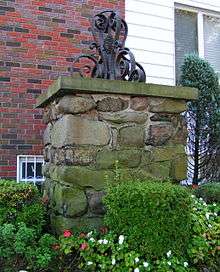
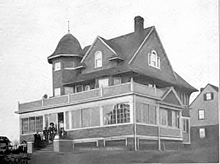
In September 1899, the Wall Street Journal even reported on the advantages of the development, recommending it to "the busy man of Wall Street" because of "its magnificent transportation facilities... it can be reached via the Thirty-Ninth Street Brooklyn Ferry and Eighty-Sixth Street Nassau Line in 45 minutes."[15] In addition, the article claimed that "the 45 minutes' trip between Dyker Heights and Wall Street by water and rail is as invigorating as the Dyker Heights climate is healthy-living. The rare opportunities afforded by Dyker Heights to the wealthy and to those in moderate circumstances are due largely to the energy, enterprise and good taste of its founder, Mr. Walter L. Johnson."[15] A month later, the Wall Street Journal published "An Ideal Spot for a Home." From that article, one can clearly see why Dyker Heights was so successful. Its location and luxurious homes were first rate, "[Dyker Heights] is without a rival as to location, situated as it is at an elevation of [110] feet above the sea level, and is directly opposite the new Dyker Meadow Park... which will be the only seaside park in Greater New York."[16] The article also explained the exclusiveness of the property, which can be seen in "its massive stone piers with heavy wrought-iron lamps and scrolls" that adorn the entrances.[16] In December 1899 the Brooklyn Eagle reported that, "work has recently been commenced upon thirty high-class Houses, the demand for which runs a dead heat with the supply."[17]
Johnson set very high standards for the community: the Wall Street Journal explained "the property is carefully restricted against all nuisances and no building can be erected upon a plot of less than 60 feet (18 m) in width by 100 feet (30 m) in depth, and each building must cost at least $4,000 and stand well back from the street."[16] These regulations, which were similar to those of Bensonhurst-by-the-Sea, were active until 1915. However, the most desirable feature of the area was still the "uninterrupted view of the lower bay from The Narrows to Sandy Hook and Atlantic Ocean, [which] is one of the most magnificent in the country, and nowhere else in the consolidated city is there anything to compare it with. From here can be seen a marine panorama hard to beat."[16] Dyker Heights was so desirous that important members of society flocked to it. The Brooklyn Eagle reported in December 1899 that this "drain" on the more established social neighborhoods such as Brooklyn Heights and those in Manhattan, "almost threatens to lower the social tone of the neighborhoods where this universal exodus is effecting a gradual change in the character of the population."[17]
Late 19th and early 20th centuries
Property on 84th Street near 13th Avenue was made available to the International Sunshine Society in 1906 by lawyer, financier, and promoter George E. Crater, Jr.[18] The society was able to acquire the house for $11,000, roughly half the market value, and opened the Dyker Heights Home for Blind Babies on 1 November 1906. Cynthia W. Alden, Mary C. Seward, and other society officers worked with the New York City Board of Education to establish the first public kindergarten for blind children at the home in 1907.[19] The original building is gone, but the work begun in Dyker Heights provided a legacy of significant reforms in the public education of blind children within New York and other regions of the United States.


One of the many focal points of the neighborhood was the Dyker Heights Club, which started in October 1896.[8] By spring of 1898 the Club had a $30,000 clubhouse designed by Albert Edward Parfitt on an $8,500 lot, measuring 200×200, located on the northeast corner of 13th Avenue and 86th Street. Johnson moved his real estate office into the clubhouse and hired a full-time architect, Constantine Schubert, who was also a Dyker Heights homeowner. This grand, neo-classical building was demolished in 1929 by the Archbishop John Hughes Knights of Columbus Club, when they acquired the property for $60,000.[20]
Early in the history of Dyker Heights, Walter L. Johnson continually purchased consecutive tracts of land until the boundaries of Dyker Heights stretched from 79th Street in the north, roughly 86th Street in the south, Tenth Avenue to the west, and about 300 feet (90 m) east of 13th Avenue to the east. However, the boundaries of the Neighborhood of Dyker Heights are now defined by the Dyker Heights Post Office on the northwest corner of 13th and 84th Streets; along its northeast edge runs Bay Ridge Avenue; 16th Avenue is its southeast boundary; Fort Hamilton makes its southwest border; and Interstate 278 is the northwest limit.[21]
Demographics
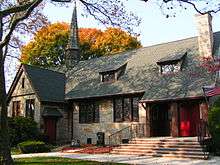
The first residents were either local government officials or wealthy professionals. For instance, I. M. De Varona was Engineer of the Water Bureau, Clarence Barrow was Ex-Fire Commissioner, William C. Bryant was current Fire Commissioner, George W. Dickinson was a cotton-goods merchant, W. Bennett Wardell was a retired Judge, Richard Perry Chittenden was Assistant of the Corporation Counsel, Freeland Willcox was Secretary of the Cheeseborough Vaseline Company, and Eugene Boucher was longshoreman and insurance broker.[8]
Italian-American homeowners in Dyker Heights originally numbered few, and included Dr. Lorenzo Ullo, Counselor to the General Company of Italian Navigation, and Simone Saitta, a Manhattan wholesale fruit dealer. However, Walter L. Johnson did not care much for Italians, especially poor Italians. The Brooklyn Eagle explained a problem Johnson had with a particular Italian family in a home "which at the time was owned by Walter L. Johnson, was occupied by an Italian family, to whom Mr. Johnson paid $600 to vacate it in order that the neighborhood of Dyker Heights, which is very carefully restricted, might have no objectionable features about it."[22] By 1940 Dyker Heights was inhabited by a majority of people of Italian descent many of whom helped establish the Roman Catholic Shrine Church of Saint Bernadette (ca. 1935) on 13th Avenue between 82nd and 83rd streets.
2010 census
Based on data from the 2010 United States Census, the population of Dyker Heights was 42,419, an increase of 3,087 (7.8%) from the 39,332 counted in 2000. Covering an area of 686.31 acres (277.74 ha), the neighborhood had a population density of 61.8 inhabitants per acre (39,600/sq mi; 15,300/km2).[1]
The racial makeup of the neighborhood was 70.2% White, 0.1% African American, 0.0% Native American, 27.1% Asian, 0.0% Pacific Islander, 0.1% from other races, and 1.0% (430) from two or more races. Hispanic or Latino of any race were 5.9% of the population.[23]
Notable residents
Notable current and former residents of Dyker Heights include:
- Scott Baio (born 1960), actor best known for his work on such programs as Happy Days, Joanie Loves Chachi, Scott Baio is 46 and Pregnant, and Charles in Charge.[24]
- Maria Bartiromo (born 1967), host of "Mornings with Maria" on the Fox Business Channel and "Sunday Morning Futures" on the Fox News Channel.[25]
- Wenjian Liu (d. 2014), NYPD officer, slain in the December 2014 killings of NYPD officers
- Joe Rollino (1905-2010), an original Coney Island Strongman, who died at the age of 104 after being hit by a car while he crossed Bay Ridge Parkway at 13th Avenue.[26][27][28]
- Rosanna Scotto (born 1958), anchor on Fox 5 News/WNYW for 25 years, grew up on 11th Avenue and 83rd Street.[29]
Houses
Design
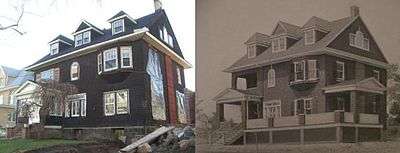

In December 1899, the Brooklyn Eagle wrote a very detailed description of the homes in Dyker Heights:
The typical Dyker Heights residences have five rooms each on the first and second floors and four rooms on the third. Upon entrance, the inmate or visitor is ushered into a hall twelve feet wide which runs back to the butler's pantry. To the right of this hall is the parlor and library and to the left the reception and dining rooms. The rear space is taken up by the kitchen, butler's pantry and washrooms with tiled floors. Birdseye maple is used in the finishing of the parlor and quartered oak in that of the library, one with mantles of the same wood in fancy tile finish. A large fireplace with ornamental andirons completes the mural decoration. The ceilings are ten feet high on the first floor, while nine feet is the elevation of the second and eight feet that of the third floor. Usually the dining room is fifteen feet square and finished off in quartered sycamore. Like the hall, the reception room is done off in quartered oak, but is circular in form and has a diameter of ten feet. In the kitchen is a glazed fireplace, while below stairs, speaking from a first floor level, are the cellar and laundry, with a depth of eight feet, and an asphalt double concrete floor.[17]
Of the five rooms on the second floor, one is a sitting room and the remainder sleeping apartments, all of which are finished in quartered oak and sycamore. A large bathroom with tiled floors takes up the remaining space of the second story. Rising to the third floor we find plain cypress as the invariable finish of the apartments, which comprise two servants’ rooms, a card or sitting room and a billiard parlor wainscoted on the sides and provided with seats for the players and onlookers. It may be noted further that the reception room and dining room are also wainscoted six feet high.[17]
Of the approximately 150 homes initially built by Walter L. Johnson, about half remain; while the others have been razed and replaced by large Mediterranean villas, condos, as well as semi and fully attached homes. Very few of the newer homes fit into the historic context of Dyker Heights, and many of the original surviving homes have been extensively renovated and remodeled.[30]
Christmas decorations
.jpg)
Dyker Heights is now most famous for its Christmas lights and decorations erected each year by its residents. It has been called "Con Ed's warmest heartthrob,"[31] the "undisputed capital of Christmas pageantry,"[32] and the "king of the Christmas lights."[33] Christmas lights are now the core of the Dyker Heights identity, because the whole community, not just one home or one block, participates.[32] As such, Dyker Heights has been referred to as "an epicenter of professionally hung Christmas lights". Most holiday decorations in the area are not erected by homeowners, but by local decorating companies, but the cost of hiring professional decorators can vary greatly, from $1,000 to $20,000 or more, depending on the scale of the display; many companies also offer additional services, including the option to take down and store decorations.[34]
Although in which December the lights began is unclear, newspaper reports and tours of the area suggest it started sometime in the 1980s. In 1985 one Lou Singer began running tours (Singer's Brooklyn) through the most elaborately light parts of Bensonhurst, Canarsie, Bay Ridge, and Dyker Heights where one could find "designer lighting."[35][36][37][38] Since those initial 1980 reports, the lights of Dyker Heights have become increasingly more popular with New Yorkers as countless newspaper articles, news programs, documentaries, and remotes were created. Early on, the two most noted homes were on 84th Street, between 11th and 12th avenues, directly across from one another. The home of Lucy Spata with her Santa theme at 1152 84th St and that of Alfred Polizzotto with his Nutcracker motif at 1145 84th St.[38][39]
Examples
In December 1998, the Spatas' home was covered in lights, illuminated soldiers and choirboys, and other Christmas figures. The inside is decorated with 50 motorized dolls, miniature villages and many gifts. Outside Santa, played by her nephew, greets children and others who pass by.[40]
The white mansion, owned by Alfred Polizzotto and his family, is adorned with a pair of 29-foot (8.8 m) high wooden soldiers which stand guard and wave their arms. The front lawn has rearing horses and a quartet of dancers. In 1988, Polizzotto was diagnosed with lymphoma, which was successfully treated the following year. To celebrate his triumph, Polizzotto mounted the display the following year and ever since. In 2001, Polizzotto died; however, his family has continued the tradition in his honor.[41]
In 1996, the Casos, who moved to Dyker Heights in 1995 and have since relocated, had Midwood artist Carl Oliveri design Charles Dickens' "A Christmas Carol," which included 29 life-size figures on their front lawn at 1062 84th St.[42]
In 2000, Conan O'Brien filmed a remote for Late Night with Conan O'Brien in Dyker Heights.[43] A PBS televised documentary "Dyker Lights" was produced in 2001 as an insight into the neighborhood with stories involving the Christmas celebration lights.[44]
Political representation
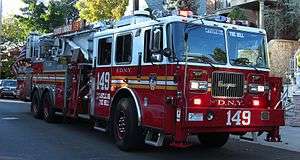
- Dan Donovan – House of Representatives of New York's 13th Congressional District.[45]
- Martin J. Golden – New York State Senate of New York's 22nd Senatorial District.[46]
- Justin Brannan – New York City Council of New York's 43rd Council District.[47]
- Peter Abbate – New York State Assembly of New York's 49th Assembly District.[48]
- Brooklyn Community Board 10 (MAP)[49]
- Dyker Heights Civic Association[50]
Civic services
- BRAVO Volunteer Ambulance – BRAVO, the Bay Ridge Ambulance Volunteer Organization[51]
- Brooklyn Public Library – Dyker Heights Branch[52]
- New York City Fire Department – Engine Company 284, Ladder Company 149[53]
- New York City Police Department – 68th Precinct[54]
- United States Post Office – Dyker Heights Branch[55]
Crime
According to the CompStat (COMPuter STATistics) database of the New York City Police Department for the 68th Precinct, Dyker Heights is one of the safest neighborhoods in all of New York City, with an 86.01% reduction in all crimes since 1990.[56] Most notably, murder is down 74% since 1990 with one case in 2014 and none in 2008.[57][58]
There were 11 reported cases of rape in 2014, consistent with a 57.7% drop since 1993. There were 79 robberies and 147 burglaries in 2014, down 83.1% and 83.9%, respectively, since 1993. Felony assault charges have decreased by 55.9% since 1990, with 105 cases in 2014. Grand larceny, having a total of 346 cases in 2014, and grand larcenies for automobiles, with 94 reports in 2014, have also dropped, 9.2% and 94% respectively.
Transportation

The center of Dyker Heights is not served by the New York City Subway, but its neighboring communities are. Bay Ridge is served by the BMT Fourth Avenue Line (R train), with stations at Bay Ridge Avenue, 77th Street, 86th Street and 95th Street.[59] The far south end of Boro Park is served by the BMT Sea Beach Line (N and W trains), with stations at Fort Hamilton Parkway and New Utrecht Avenue.[60] Bensonhurst is served by the BMT West End Line (D train), with stations at 79th Street, 71st Street and 62nd Street.[61]
Several local New York City Bus routes and one express route serve Dyker Heights; the routes are B1, B4, B16, B64, B70, X28.[62]
Dyker Heights is accessible by car via the Belt Parkway as well as the Interstate 278 (Verrazano-Narrows Bridge to Staten Island, Gowanus Expressway, and Brooklyn-Queens Expressway).
Named streets
- Lieutenant William E. Coffey Square – 81st Street, between 7th Avenue and Fort Hamilton Parkway. In the square stands one flagpole and two upright granite stones. One stone contains a bronze plaque inscribed with "In Memory Of Those Members Of Our Armed Forces Who Gave Their Lives For Our Country These Dead Shall Not Have Died In Vain" and the other stone has an incised scene of Iwo Jima.[63][64]
- Marie Walsh Corner – southwest corner of 84th Street and 7th Avenue. Marie Walsh was a dedicated community activist being a member of the Dyker Heights Civic Association, Bay Ridge Community Council, and the Kings County Conservative Party. She also helped to establish the X28 bus. On June 10, 1996 Mayor Rudolph W. Giuliani signed the bill into law.[65][66]
- Dyker Heights Boulevard – 13th Avenue, between 86th Street and Bay Ridge Avenue. On August 8, 2001 Mayor Rudolph W. Giuliani signed the bill into law.[67]
- Firefighter Dennis Patrick O'Berg 9/11 Memorial Way – 74th Street, between 10th and 11th Avenues. Although he graduated from the State University of New York at Geneseo with a degree in accounting, O’Berg followed in his father's footsteps and became a firefighter. He was a member of Ladder 105, in the Prospect Heights section of Brooklyn. On October 20, 2003 Mayor Michael R. Bloomberg signed the bill into law.[68][69]
- Robert F. Tipaldi 9/11 Memorial Way – 80th Street, between 7th and 10th Avenues. Tipaldi was a 25-year-old t trader with Cantor Fitzgerald on the 104th floor of World Trade Center Tower 1. On December 21, 2004 Mayor Michael R. Bloomberg signed the bill into law.[70][71]
- Maria LaVache 9/11 Memorial Way – 72nd Street between 11th and 12th Avenues. LaVache was a long-time receptionist for J&H's International Department but was transferred to another office on the 99th floor of the World Trade Center.[72] On December 21, 2004 Mayor Michael R. Bloomberg signed the bill into law.[70]
- Charles J. Mauro 9/11 Memorial Way – 72nd Street between 11th and 12th Avenues. On December 21, 2004 Mayor Michael R. Bloomberg signed the bill into law.[70]
- Arturo Angelo Sereno 9/11 Memorial Way – 12th Avenue and 67th Street. On December 21, 2004 Mayor Michael R. Bloomberg signed the bill into law.[70]
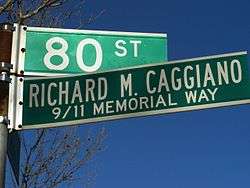 Street sign for Richard M. Caggiano 9/11 Memorial Way
Street sign for Richard M. Caggiano 9/11 Memorial Way - Richard M. Caggiano 9/11 Memorial Way – 80th Street, between 10th and 11th Avenues. Caggiano worked for Cantor Fitzgerald. On April 14, 2005 Mayor Michael R. Bloomberg signed the bill into law.[73][74]
- Frederick I. Ergang Way – 12th Avenue and Bay Ridge Avenue. Having been raised in Borough Park, he was principal of P.S. 176 at 69th Street and 12th Avenue from 1973 until his retirement in 1998. At the time of his retirement he had the second longest tenure of any educator in the city of New York.[75][76] On May 5, 2004 Mayor Michael R. Bloomberg signed the bill into law.[77]
- Det. Frank P. Collins Avenue – 72nd Street and 7th Avenue. Collins was a sergeant in the United States Army, where he toured Bosnia, and an officer with New York City Police Department, working as a narcotics detective in the 63rd precinct. He died in a motorcycle accident on June 12, 2002.[75] On May 5, 2004 Mayor Michael R. Bloomberg signed the bill into law.[77]
- Giuseppe "Joe" Papandrea Way – 86th Street between 15th and 16th Avenues. Born in Calabria, Italy, Papandrea immigrated to Brooklyn. A leukemia survivor, he was killed by a hit and run driver om this blockon January 29, 2002.[75] On May 5, 2004 Mayor Michael R. Bloomberg signed the bill into law.[77]
- De Russy Drive – Circular drive in front of the Dyker Beach Golf Course Club House, connecting 7th Avenue with 86th Street. From approximately 1870 to 1930, an earlier ‘De Russy Street’ ran within this same parcel, as the northern-most section of the golf course was 92nd Street. This street ran perpendicular to 86th Street and some 130 feet (40 m) west of 11th Avenue and it was demapped when the park was expanded northward in the 1930s. Both the Dyker Heights Civic Association and the Dyker Heights Historical Society were instrumental in the naming of the street after General Rene E. De Russy. It was redesignated in July 2009.[78][79][80][81]
- Walter L. Johnson Corner – 82nd Street and 11th Avenue, southwest corner. Johnson developed Dyker Heights in about 1895 to 1905. This was the corner on which he built his house, the first at Dyker Heights. The Dyker Heights Civic Association, the Dyker Heights Historical Society, and Council Member Vincent J. Gentile, of the 43rd district, were instrumental in the naming of this corner.[82][83][84][85] On December 28, 2009 Mayor Michael R. Bloomberg signed the bill into law.[86]
- Hank Vogt Way – at the intersection of 85th Street and 7th Avenue. In 1974, Vogt established, and became the first chair of the Bay Ridge Ambulance Volunteer Organization. He was also Parade Chairman of the Ragamuffin Parade for many years as well as chairman of Planning Board 10. Council Member Gentile helped secure the corner's redesignation.[82] On December 28, 2009 Mayor Michael Bloomberg signed the bill into law.[86]
Institutions
Churches
- Shrine Church of Saint Bernadette (Roman Catholic)[87]
- St. Rosalia-Regina Pacis Parish (Roman Catholic)[88]
- St. Ephrem's (Roman Catholic)[89]
- St. Philip's (Episcopal)[90]
- Lefferts Park Baptist Church (Independent Baptist)[91]
Education
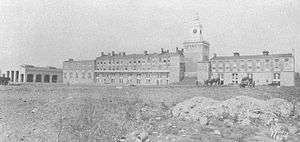
Private
- Poly Prep Country Day School (Pre-K – 12th Grade)[92]
Parochial
- Leif Ericson Day School (Pre-K – 8th Grade; Evangelical Lutheran Church in America)[93]
- St. Bernadette School (Pre-K – 8th Grade; Roman Catholic)[94]
- St. Ephrem School (Pre-K – 8th Grade; Roman Catholic)[95]
Public
- JHS 201 Dyker Heights (6th Grade – 8th Grade)[96]
- JHS 259 William Mckinley (6th Grade – 8th Grade)[97]
- PS 127 Mckinley Park (Kindergarten – 5th Grade)[98]
- PS-IS 229 Dyker (Pre-Kindergarten – 8th Grade)
- PS 204 Vince Lombardi (Pre-Kindergarten – 5th Grade)
- PS 163 Bath Beach (Pre-Kindergarten-5th Grade)
- PS 112 Lefferts Park (Kindergarten-5th Grade)[99]
- PS 176 The Ovington School (Kindergarten – 5th Grade)http://www.ps176.org/
Early childhood education
- Lefferts Park Baptist Church Daycare (2 years old – 6 years old)[100]
Park and golf course
There is a public park and a municipal, 18-hole,[101] championship golf course[102][103] in southwestern Dyker Heights.
References
- 1 2 Table PL-P5 NTA: Total Population and Persons Per Acre - New York City Neighborhood Tabulation Areas*, 2010, Population Division - New York City Department of City Planning, February 2012. Accessed June 16, 2016.
- 1 2 "Dyker Heights: Brooklyn Community Board 1: Neighborhoods". Brooklyn Community Board 10, City of New York. Retrieved May 12, 2018.
- ↑ "Friends of Historic New Utrecht". Historicnewutrecht.org. Retrieved 2014-06-12.
- ↑ "West Point Museum Collections"
- ↑ "Archived copy" (PDF). Archived from the original (PDF) on 2015-09-23. Retrieved 2014-06-10.
- ↑ "Find a Grave". Find a Grave. Retrieved 2014-06-12.
- ↑ Brooklyn Eagle, "Frederick H. Johnson's Sudden Death." August 15, 1893, p. 1.
- 1 2 3 4 5 "Saitta House – Report Part 1 Archived 2008-12-16 at the Wayback Machine.", DykerHeightsCivicAssociation.com
- 1 2 Marc Linder and Lawrence S. Zacharias, Of Cabbages and Kings County: Agriculture and The Formation of Modern Brooklyn (Iowa City: University of Iowa Press, 1999), p. 275.
- ↑ https://www.nytimes.com/2008/07/13/realestate/13livi.html
- ↑ Brooklyn Eagle, "Buys Brooklyn Realty," January 17, 1897, p. 5.
- ↑ Brooklyn Eagle, "Real Estate Market," April 5, 1898, p. 14.
- ↑ Brooklyn Eagle, "Dyker Heights Club House," April 24, 1898, p. 10.
- ↑ Brooklyn Eagle, "Real Estate Market," February 1, 1899, p. 14.
- 1 2 Wall Street Journal, "Dyker Heights and Wall Street," September 22, 1899, p. 5.
- 1 2 3 4 Wall Street Journal, "An Ideal Spot for a Home," October 24, 1899, p. 2.
- 1 2 3 4 Brooklyn Eagle, "Dyker Heights Development," December 31, 1899, p. 28.
- ↑ Stewart, William R., ed. (1914) [1914], Annual report of the state board of charities, 1, Albany: J. B. Lyon Company, pp. 753–755
- ↑ State of New York (1918) [1918], Documents of the Senate, 141st Session, Albany: J. B. Lyon, p. 151
- ↑ One hundredth Anniversary Journal of the Archbishop John Hughes Knights of Columbus Club, 2000.
- ↑ "DYKER HEIGHTS, Brooklyn | | Forgotten New YorkForgotten New York". Forgotten-ny.com. Retrieved 2014-06-12.
- ↑ Brooklyn Eagle, "Used Advertising Cards." April 5, 1897, p. 16.
- ↑ Table PL-P3A NTA: Total Population by Mutually Exclusive Race and Hispanic Origin - New York City Neighborhood Tabulation Areas*, 2010, Population Division - New York City Department of City Planning, March 29, 2011. Accessed June 14, 2016.
- ↑ "Wa,wa,wa! Scott Baio comes home", Bay Ridge Courier, October 11, 2007
- ↑ Atkinson, Claire. "Maria Bartiromo heading to Davos", New York Post, January 5, 2014. Accessed February 4, 2017. "Meanwhile, the former Money Honey has been busy tweeting photos of place settings at a White House dinner party, holiday lights in Dyker Heights, Brooklyn, where she grew up, and a few promotional re-tweets for her new colleagues at the Fox News Channel."
- ↑ At a Mighty 104, Gone While Still Going Strong New York Times by Manny Fernandez and Michael S. Schmidt, January 11, 2010
- ↑ Famed Coney Island strongman Joe Rollino, 104 (aka 'Kid Dundee') killed after minivan hit NY Daily News by Jill Colvin, Rocco Parascandola and Corky Siemaszko: Monday, January 11th 2010
- ↑ Bay Ridge Accidents Kill Three Victims, Including Man, 104 Brooklyn Eagle by Raanan Geberer Monday, January 11th 2010
- ↑ D'Arienzo, Sr. Camille. "New York TV news anchor talks of life off-camera", National Catholic Reporter, May 15, 2012. Accessed February 4, 2017. "[NCR] Where did you spend your childhood? [Scotto] Growing up in Dyker Heights, Brooklyn, was great."
- ↑ "Saitta House – Report Part 3 Archived 2008-12-16 at the Wayback Machine.",DykerHeightsCivicAssociation.com
- ↑ So Bright You Might Say It Glows "New York Times" By Douglas Martin: December 18, 1998
- 1 2 If You're Thinking of Living In/Dyker Heights, Brooklyn Near the Giant Verrazano, a Human Scale "New York Times" March 9, 1997
- ↑ All Is Bright Silent Night, But Lots Of Lights "NY Daily News" Joyce Shelby, December 22nd 1996
- ↑ Rob Abruzzese (9 December 2013). "Christmas displays put Dyker Heights on tourist map". Brooklyn Eagle. Retrieved 5 November 2014.
- ↑ The Spirit of Christmas Reigns On the Sidewalks of New York "New York Times" By Andrew L. Yarrow: December 25, 1987
- ↑ Neighborhoods Santa Has No Trouble Finding "New York Times" By Andrew L. Yarrow: December 22, 1989
- ↑ Holiday Sights "New York Times" December 15, 1991
- 1 2 Calendar: Holiday Scenes, All Around "New York Times" December 17, 1992
- ↑ Let There Be Lights... "Newsday" By Margalit Fox: December 20, 1991
- ↑ The Lights Before Christmas The Holidays Are Always High-Voltage In This B'klyn Nabe "NY Daily News" By Sheila Anne Feeney, November 29th 1998
- ↑ Highlight Of Dyker Heights "NY Daily News" By Stephen Mcfarland, June 4th 1995
- ↑ Daily News Guide Holiday Sights & Sounds "NY Daily News" December 14th 1998
- ↑ Short on Subway Stops, Long on Christmas Lights New York Times by Gregory Beyer, July 13, 2008.
- ↑ Program Info: Dyker Lights From thirteen.org
- ↑ Archived September 15, 2008, at the Wayback Machine.
- ↑ "Martin J. Golden | New York State Senate". Senatorgolden.com. Archived from the original on 2009-06-04. Retrieved 2014-06-12.
- ↑ "District 43 – Council Member – Democrat". Council.nyc.gov. Retrieved 2014-06-12.
- ↑ http://assembly.state.ny.us/mem/Peter-J-Abbate-Jr/
- ↑ "Brooklyn Community Board 10 (Bay Ridge, Dyker Heights, and Fort Hamilton): Home". Bkcb10.org. Retrieved 2014-06-12.
- ↑ "Dyker Heights Civic Association, Inc". Dykerheightscivicassociation.com. Retrieved 2014-06-12.
- ↑ "Bravo Volunteer Ambulance | Brooklyn Bayridge New York". Bravoambulance.org. 2014-03-18. Retrieved 2014-06-12.
- ↑ "Hours & Locations". Brooklyn Public Library. Archived from the original on 2011-10-25. Retrieved 2014-06-12.
- ↑ "FDNY – The Official Fire Department, City of New York, Web Site". Nyc.gov. Retrieved 2014-06-12.
- ↑ "NYPD – Precincts". Nyc.gov. 2011-02-16. Retrieved 2014-06-12.
- ↑ "Find Mail Services in 11228 – Brooklyn, NY". Usps.whitepages.com. Archived from the original on 2009-07-10. Retrieved 2014-06-12.
- ↑ CompStat Archived 2010-05-28 at the Wayback Machine. 68th Precinct of the NYPD
- ↑ Zero Murders for 2008 in Bay Ridge, Dyker Heights and Fort Hamilton: "Safe" 68th Precinct Only One of Three in City with No Murder Reports Archived 2011-07-10 at the Wayback Machine. The Bay Ridge Eagle. January 8, 2009, by Harold Egeln
- ↑ Bay Ridge Cop Killed By Heart Attack at 28 The Brooklyn Eagle. February 2, 2009, by Angelo Rotondaro
- ↑ "R Subway Timetable, Effective June 24, 2018" (PDF). Metropolitan Transportation Authority. Retrieved June 24, 2018.
- ↑ "N Subway Timetable, Effective June 24, 2018" (PDF). Metropolitan Transportation Authority. Retrieved June 24, 2018.
- ↑ "D Subway Timetable, Effective June 24, 2018" (PDF). Metropolitan Transportation Authority. Retrieved June 24, 2018.
- ↑ "Brooklyn Bus Map" (PDF). Metropolitan Transportation Authority. November 2017. Retrieved April 24, 2018.
- ↑ "Permanent Art and Monuments : NYC Parks". www.nycgovparks.org. Retrieved 2017-10-14.
- ↑ "DYKER and BATH BEACHES, Brooklyn - Forgotten New York". forgotten-ny.com. November 2006. Retrieved 2017-10-14.
- ↑ "Press Release Archives - 260-96 - Laws on Base Station Licenses, Sister Helen Patrick Howley, Reverend Joseph May, Marie Walsh". www.nyc.gov. June 10, 1996. Retrieved 2017-10-14.
- ↑ nyccouncil.info Local Law 49 of 1996 "Marie Walsh Corner"
- ↑ "Press Release Archives #282-01 - MAYOR GIULIANI SIGNS BILL ADDING NAME "DYKER HEIGHTS BOULEVARD" TO 13TH AVENUE, BETWEEN 86TH STREET AND BAY RIDGE AVENUE, BROOKLYN". www.nyc.gov. August 8, 2001. Retrieved 2017-10-14.
- ↑ "Mayor Michael R. Bloomberg Signs Legislation Naming 77 Streets", October 20, 2003
- ↑ Revisiting September 11th...Remembering Dennis O'Berg
- 1 2 3 4 "Mayor Michael R. Bloomberg Signs Legislation Renaming Eighty-three Streets". nyc.gov. 2004-12-21. Retrieved 2017-10-14.
- ↑ "Remembering September 11, 2001: Robert Frank Tipaldi Obituary". Legacy.com. Retrieved 2017-10-14.
- ↑ "Tribute Page for Maria La Vache"
- ↑ nyccouncil.info Naming Of 45 Thoroughfares And Public Places
- ↑ "September 11 Memorial". CNN. 2003-09-09. Retrieved 2017-10-14.
- 1 2 3 "File #: Int 0281-2004". The New York City Council. May 2004. Retrieved 2017-10-14.
- ↑ CB10 OKs ‘Ergang Way,’ 15 others "THE BROOKLYN PAPERS" Page 5. March 27, 2004
- 1 2 3 "Mayor Michael R. Bloomberg Signs Legislation Renaming 94 Streets". nyc.gov. 2004-05-05. Retrieved 2017-10-14.
- ↑ Dyker Beach Golf & Catering Hall Ribbon Cutting Ceremony, Brooklyn Eagle, 07-09-2009
- ↑ Path Through Park Given Name of 1800s General De Russy, Brooklyn Eagle, 07-09-2009
- ↑ ‘De Russy Drive’ makes its official debut, Bayside Times, 07-09-2009
- ↑ General DeRussy Individual Honoree Document and Figures Archived 2010-04-15 at the Wayback Machine., DykerHeightsCivicAssociation.com
- 1 2 "File #: Int 1103-2009". The New York City Council. Retrieved 2017-10-14.
- ↑ Council passes five local street renaming yournabe.com Thursday, December 31, 2009
- ↑ Council passes five local street renamings yournabe.com, Thursday, January 14, 2010
- ↑ Dyker Heights’ Founder To Be Honored With Street Corner Name Brooklyn Daily Eagle, by Harold Egeln January 18, 2010
- 1 2 "Mayor Bloomberg Signs Legislation Renaming 70 Thoroughfares and Public Places". nyc.gov. 2009-12-28. Retrieved 2017-10-14.
- ↑ "Shrine Church of Saint Bernadette". Shrinechurchofstbernadette.com. Retrieved 2014-06-12.
- ↑ "St. Rosalia-Regina Pacis Parish". Parishesonline.com. 2011-12-09. Retrieved 2014-06-12.
- ↑ "St. Ephrem's". Stephremchurch.org. Archived from the original on 2014-07-14. Retrieved 2014-06-12.
- ↑ "St. Philip's". Stphilipsbrooklyn.com. 2014-06-08. Retrieved 2014-06-12.
- ↑ "Lefferts Park Baptist Church – A Christian church serving Dyker Heights, Bensonhurst, Bay Ridge & the borough of Brooklyn. Our contemporary Sunday services are held at 11a". Brooklynforchrist.com. Retrieved 2014-06-12.
- ↑ "Poly Prep Country Day School". Polyprep.org. Retrieved 2014-06-12.
- ↑ "Leif Ericson Day School". Leds.home.mindspring.com. Retrieved 2014-06-12.
- ↑ "St. Bernadette". Stbernadetteschool.org. Retrieved 2014-06-12.
- ↑ "St. Ephrem". Schools.privateschoolsreport.com. Retrieved 2014-06-12.
- ↑ "JHS 201 Dyker Heights". Schools.nycenet.edu. Archived from the original on 2015-12-27. Retrieved 2014-06-12.
- ↑ "JHS 259 William Mckinley". Schools.nyc.gov. 2010-01-06. Retrieved 2014-06-12.
- ↑ "PS 127 Mckinley Park". Schools.nyc.gov. 2013-10-24. Retrieved 2014-06-12.
- ↑ "PS 112 Lefferts Park". Schools.nyc.gov. Retrieved 2014-06-12.
- ↑ "Lefferts Park Baptist Church Daycare". Brooklynforchrist.com. Archived from the original on 2014-09-20. Retrieved 2014-06-12.
- ↑ Dyker Beach Golf Course Brooklyn, NY American Golf
- ↑ Perry, Jane (August 22, 1955). "Brooklyn's Mad Golf Course". Sports Illustrated. Retrieved May 14, 2013.
- ↑ Busch, Noel F. (May 21, 1938). "Tea and Green". The New Yorker: 61. Retrieved May 14, 2013.
External links



